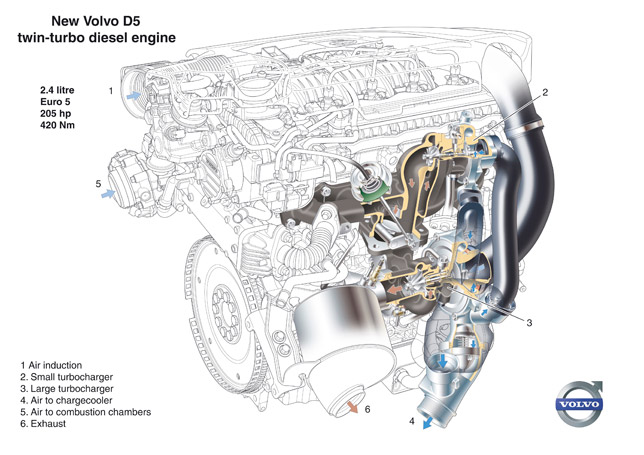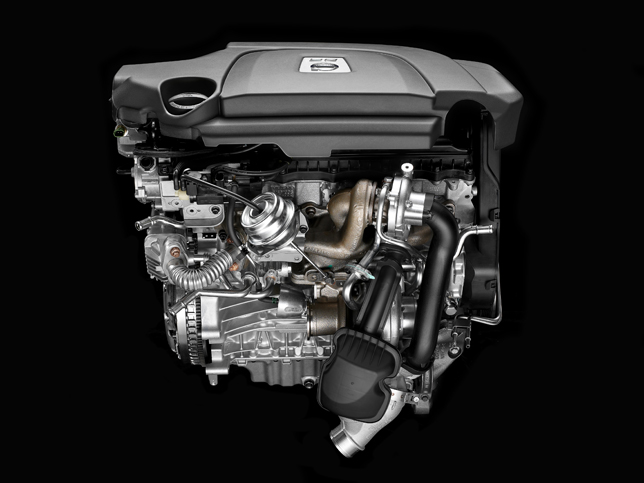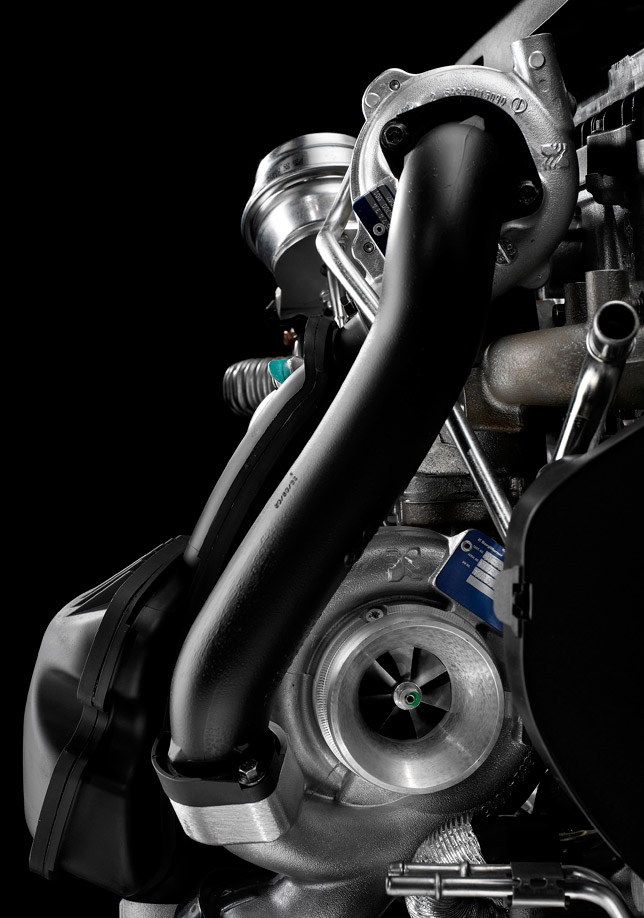Spearhead technology gives Volvo's new Euro 5 diesel top performance and record-low fuel consumption
Volvo Cars is now introducing an entirely new 2.4-litre 5-cylinder diesel engine in the Volvo S80. It is in principle just the D5 badge and the five-cylinder configuration that it shares with the previous generation. The new engine is certified according to Euro 5 and is significantly more efficient that its predecessor.
With high-tech solutions such as sequential twin turbochargers, ceramic glow-plugs and piezoelectric fuel injectors, Volvo's engineers have succeeded in cutting fuel consumption to record-low levels for a car of this size - 6.2 litres/100 km. CO2 emissions are 164 g/km.
This low fuel consumption in combination with power output of 205 hp and no less than 420 Nm of torque means the Volvo S80 with D5 engine is bidding for the title of best in class.
"Our brief was to develop a modern performance diesel that meets the Euro 5 norm," says Derek Crabb, Vice President, Powertrain Engineering. "The previous engine generation has undergone constant development in a series of stages and had reached the end of its potential. We therefore decided to start with a clean sheet of paper and harness the advanced technology to which we have access today. The result is even better than we dared hope. What is more, this engine has been developed entirely in-house at Volvo."
Performance and driving comfort of top class
Volvo's new D5 engine has a displacement of 2.4 litres, offering power and response at the touch of the accelerator. It offers the best imaginable driveability and smoothness, whatever the situation, not least in urban driving. With an automatic gearbox this is particularly evident. The wide torque of the engine in combination with extremely rapid automatic gear shifting provides an extraordinary smooth ride with dramatically improved real life fuel consumption.
The performance and driveability requirements have been solved with twin turbochargers of different sizes that operate in sequence to provide added power within a broader rev range. The result is alert response and rapid acceleration at all speeds, with very smooth power delivery between the two turbo ranges. This power means there are always ample resources for quick overtaking, particularly between 80 and 120 km/h. The smooth transition provides a very sophisticated driving experience.
Advanced injection technology using piezoelectric fuel injectors provides precise distribution of the atomised fuel in the combustion chamber, resulting in efficient combustion and low emissions. At the same time, this technology and the efficient combustion create a pleasant sound bearing a closer resemblance to the elegant note of a six-cylinder petrol engine. The engine offers excellent results in terms of noise comfort and noise perception, technically known as NVH or Noise, Vibration and Harshness.

Fuel consumption lower than target
"When the project got under way, our goal was to bring fuel consumption down to 6.4 litres/100 km in the Volvo S80, which after all is a relatively large car," recalls Derek Crabb. "As the work progressed we saw that we could beat that target and today we are actually down to 6.2. With an automatic gearbox we have been able to reduce the consumption with more than 8 percent, from 7.3 to 6.7, which is a significant improvement."
This low fuel consumption is a result of the engine's advanced technology including the two sequentially harnessed turbochargers that help reduce fuel consumption throughout a very wide rev and torque range.
This twin-turbo technology has also made it possible to introduce higher levels of exhaust gas recirculation (EGR) across a wider rev range than before. This harnesses the two turbochargers' different properties optimally to deliver high performance and low fuel consumption.
The injection system with its piezoelectric fuel injectors and high-efficiency fuel pump also helps cut fuel consumption through extremely rapid and precise injection sequences and high injection pressure, resulting in particularly effective combustion.
Low emissions and easy breathing
"The technical solutions that contribute to this low fuel consumption also help reduce the engine's environmental footprint," explains Derek Crabb. "Reducing emissions and particulates was one of the basic requirements when the new engine was being developed."
In addition to twin turbochargers, piezoelectric fuel injectors and improved EGR control, the new D5 engine has been equipped with ceramic glow-plugs, a high-tech solution that delivers excellent starting properties owing to very quick warming up. They reach a temperature of 1000 degrees Celsius in just two seconds, making the engine easy to start and cutting emissions. In certain driving conditions, such as at really low revs, the ceramic glow-plugs can also be used to increase the temperature in the cylinders, further improving combustion efficiency.
The advanced injection technology makes it possible to supply additional fuel in tiny increments after the main injection charge, a process known as post-injection, with the aim of removing any soot particulates in the exhaust gases.
In order to ensure low particulate emissions, the engine has to be able to breathe easily and efficiently. And here Volvo's engineers have succeeded particularly well thanks to optimised control of air delivery to the cylinders.
"Thanks to the perfect breathing and the low particulate emissions, we have substantially reduced exhaust emissions and can proudly equip the new Volvo S80 D5 with twin tailpipes," says Derek Crabb.

Three years from project start to delivery
The new five-cylinder diesel is the first engine from Volvo's new project office for diesel engine development.
"The entire process from receiving the brief to installing the first engine in a car has taken less than three years, which is very good indeed," says Derek Crabb. "And we'll be accompanying this engine throughout its lifetime, making it easier for us to continually develop and optimise it for other Volvo models."
The aim was to develop a diesel engine with performance and driving comfort that satisfied the high demands of customers in the S80 segment. It also had to be tailored to meet forthcoming strict environmental requirements.
The engine was developed on a modular basis in terms of both design and building method, using standardised mountings for the turbochargers and other components. This makes it easier to install in other Volvo models and creates more scope for further development to meet future demands.
"The modular approach also makes the engine easier to build in the factory," reveals Derek Crabb. "In order to create the right preconditions for assembly, with good ergonomics for the fitters and high production quality, we have implemented an ongoing exchange of experiences and ideas with the very experienced staff in our engine factory."

The technology in brief
The D5 engine is made entirely out of aluminium. This gives low weight and good heat dissipation properties.
Transverse cooling gives uniform cooling of the cylinder head and engine block. This promotes a controlled temperature throughout the engine and contributes to high reliability and long lifetime.
The two turbochargers are of different sizes and together deliver extremely high boost pressure, 1.8 bar, across a particularly broad rev range. The smaller turbocharger is used primarily at lower revs. It reacts more alertly than the larger one and provides immediate response to quick throttle movements. At higher revs, the larger turbocharger takes over to provide more propulsion when accelerating at higher speeds. In addition to increased performance and reduced fuel consumption, the twin-turbo approach makes it possible to exploit the EGR system more efficiently than before.
By increasing the volume of the EGR cooler and equipping it with effective cooling fins, it has been possible to increase heat dissipation efficiency by no less than 25 percent. This in turn gives the returning exhaust gases far lower temperature, thus reducing emissions of nitrogen oxides (NOX) to a level that easily matches the Euro 5 requirements. NOX contributes to the formation of ground-level ozone and is one reason for over-fertilisation and acidification of soil and water. NOX also affects the respiratory system.
The piezoelectric fuel injectors are used in combination with a highly efficient high pressure fuel pump to achieve very high injection pressure, a massive 1800 bar.
This type of injector has a nozzle with a response time that is twice as fast as that of a conventional injector nozzle. As a result, the amount of fuel injected can be tailored immensely precisely to suit any operating condition, which in turn promotes effective combustion, lower fuel consumption and reduced emissions of harmful substances.
Owing to its speed, a piezoelectric injector nozzle can deliver up to seven separate injection events during each operating cycle. Thanks to this speed and the high fuel delivery pressure, the injector nozzle can provide short pre-delivery injections even when engine revs exceed 3000 rpm, explaining why the engine runs so quietly.
The piezoelectric injector nozzle can also produce extremely short post-delivery injections of fuel after the main injection sequence. As a result, the particulate filter can be regenerated even when the engine is running at low revs.
The D5 engine features common rail injection via a stainless steel fuel rail that is specially designed to withstand the high pressures. Injection pressure can be as high as 1800 bar.
The fuel pump is a high-pressure unit with two pump elements instead of three as in the previous D5 engine generation. This makes the pump spin more easily, thus reducing the load on the various components. A more easily driven pump also reduces fuel consumption.
Ceramic glow-plugs are high-tech components that provide excellent starting properties. They are heated up extremely quickly and reach 1000 degrees Celsius just two seconds after a cold start. Maximum operating temperature is 1300 degrees, which is about 30 percent higher than that of a conventional glow-plug. With ceramic glow-plugs, the engine can be started immediately without pre-heating, even at temperatures as low as minus 30 degrees Celsius.
Instead of using an oil dipstick the driver is alerted via the information display when it is time to top up with oil. The system even specifies how much oil is needed.
Finally, the engine mountings have been further developed and tailored to suit the high torque levels. They are supplemented with a third torque rod to stabilise the engine during firm acceleration.
Engine specification, new D5, Euro 5 (Volvo S80)
No. of cylinders 5 Displacement, cc/cu inches 2400/146.5 Bore, mm/inches 81.0/3.19 Stroke, mm/inches 93.15/3.667 No. of valves 20 Camshafts Twin overhead Compression ratio 16.5:1 Idling revs 700 Max revs 5000 Max output (kW/rps) 151/67 Max output (hp/rpm) 205/4000 Max output (Eng hp/rpm) 202/4000 Max torque (Nm/rps) 420/29-50 Max torque (kpm/rpm) 42.8/1500-3250 Max torque (ft.lbf/rpm) 310/1500-3250 Engine management system Electronically controlled common rail direct injection Injection pressure, bar 1800 Turbo pressure, kPa 180 Particulate filter Self-regenerating
"In conclusion, Volvo's new high-tech 5-cylinder diesel engine marks yet another step in our determination to reduce the combustion engine's environmental impact, at the same time as we give S80 customers a truly quiet and sophisticated engine with excellent performance," concludes Derek Crabb.





